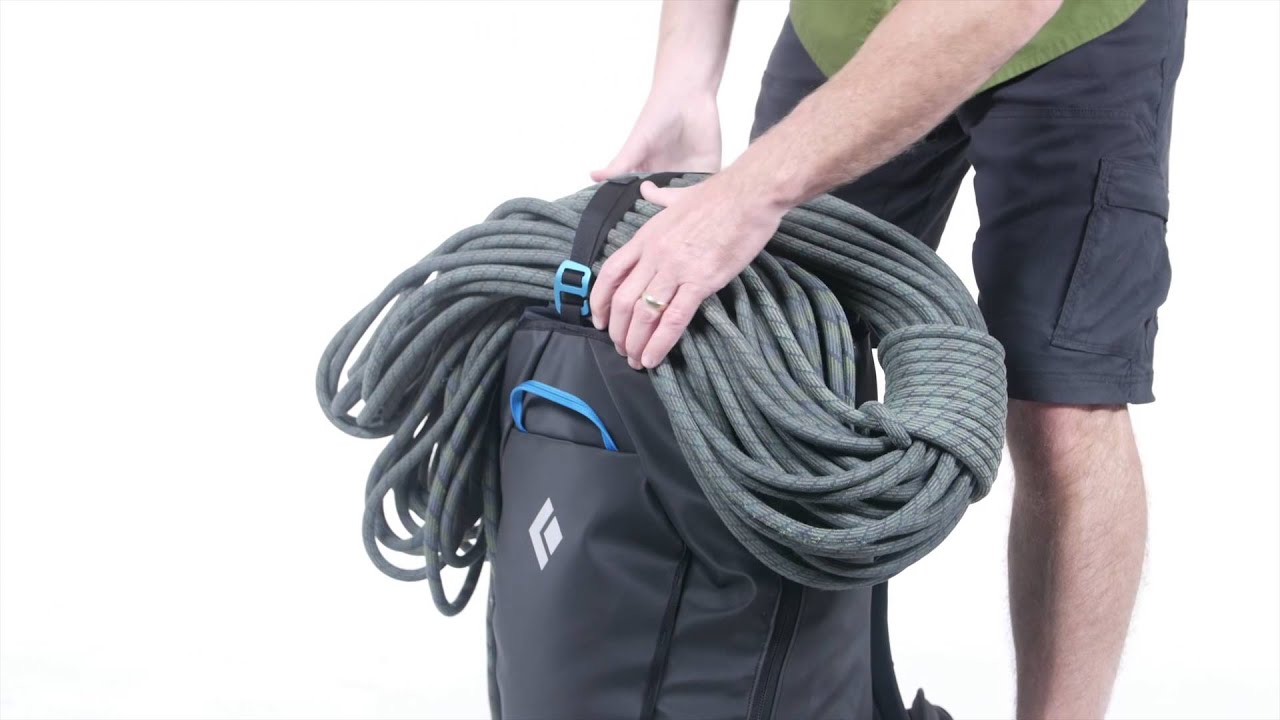How did I decide on the Creek 50 climbing pack?
Here is what I learned in looking for a sturdy, functional pack with a capacity greater than the typical 20- to 35-liter climbing pack. There are several considerations in selecting one of many good-looking designs and I hope that my observations on the success or failure of the features of the Black Diamond Creek 50 will be useful to anyone looking for a new crag pack.
A year ago, my 30-year old Wild Country pack was in tatters. I purchased the Black Diamond Creek 50 climbing pack because I wanted a climbing pack that could easily accommodate a full trad rack (ideally doubles or triples for cams), rope, shoes, helmet, food, water, extra clothes and extras (first aid kid, diabetes medication, wallet, keys, cell phone, guidebook). I was tired of a bulging pack that required I strap half my load to the exterior and, as a result, carried poorly or failed to accommodate my load altogether. Rather than using a pack designed for backpacking, I wanted something that I could haul if necessary and had greater abrasion resistance. I wanted a climbing pack that offered more sophisticated access to items within the pack; up-ending your gunny sack is admittedly quick but it’s hardly efficient. And I wanted a pack that carried well while hiking off-trail and scrambling which is my typical J-Tree Wonderland of Rocks experience. Additionally, the pack needed to be capable of handling 10-15+ kilograms (20-35lbs) loads with at least some degree of comfort. Essentially, it came down to capacity, durability, access, and comfort. And of course, cost was a factor too.
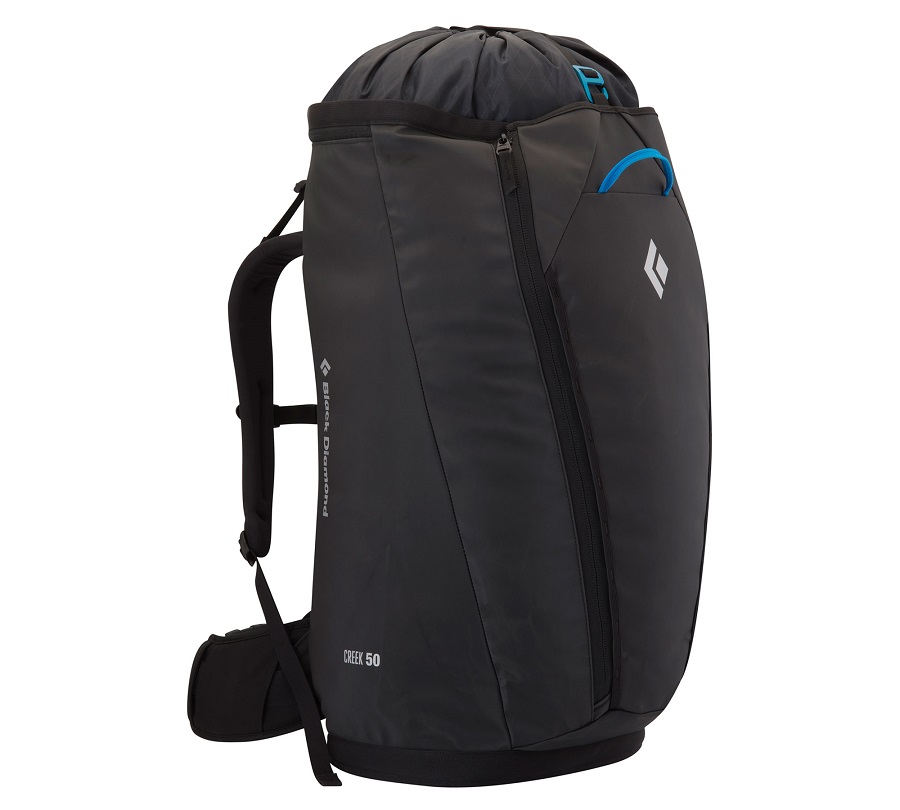
Black Diamond Creek 50 Description
The Black Diamond Creek 50 climbing pack is essentially a haul bag with some clever interior features offering top-load and side-zip access with a comfortable suspension system (shoulder & waist straps). A hard-plastic sheet in an interior sleeve provides some rigidity for the suspension and will prevent that set of rigid stem Friends from digging into your back. A clever interior separator for the main compartment effectively provides a large secondary compartment with two more smaller zippered pockets for keys, cell phone, wallet, and other small necessities. There’s a pull-out rain cover/helmet-pouch/rope-holder which is more clever than functional. I pull it out if I get caught in the rain, but otherwise, I don’t use the rain cover. The waist belt is removable, but the shoulder straps are not. The pack is hydration pouch-compatible. See these features in the Black Diamond video below.
Table 1, below, shows the climbing packs that I considered including their size in liters, price, the basic design for how the pack is closed, and other notes of interest. I was unable to examine any of these climbing packs hands-on and my pre-purchase evaluation was based on the details provided by the manufacturers and, in a few cases, reviews by other folks who actually field-tested the pack. Because I wanted something capable of carrying a fairly large load, I decided that something around 50 liters would be ideal. I looked at some smaller climbing packs too because I wanted to get a broad sense of what features are available.
| Manufacturer | Model | Size (l) | Price | Closure | Notes |
| Black Diamond | Creek 50 | 50l | $210 | drawcord | 2 internal sections w interior pockets |
| DMM | Vector | 45l | $130 | drawcord | rack insert; bright interior |
| Fish | Deluxe Atomsmasher | 38l | $130 | drawcord | the collar adds 12 liters of storage; removable suspension |
| Mammut | Trion Pro | 50l | $190 | fold-over lid | more of a backpacking or alpine design |
| Metolius | Freerider | 41l | $140 | fold-over lid | small but clean design; rugged |
| Patagonia | Cragsmith | 45l | $200 | zippered lid | zippered access to main compartment (‘clamshell’) |
| The North Face | Cinder 55 | 55l | $170 | fold-over lid | streamlined; Croft design; zippered pockets for extras |
| Trango | Crag Pack | 48l | $100 | zippered lid | guidebook pocket; exterior pockets look vulnerable |
Capacity
This 50l climbing pack met my capacity needs perfectly; I can easily carry (well, easily fit, maybe not carry) an Indian Creek rack, two ropes, two pairs of shoes, harness, slings, helmet and biners on top of the basic necessities (food & water, extra clothing, smaller items). That secondary compartment functions as a large exterior pocket and is a handy place to stuff extra layers for quick access. On a few rare occasions, I’ve had more gear than I could fit inside the pack, but the twin daisy chains and the top closure/compression strap have made it easy to festoon the pack with the excess, securely if not elegantly. Be warned: it’s axiomatic that you’ll use the space if it’s available and I’m sure I now regularly carry more than I need!
Durability
The Black Diamond Creek 50 is well built. After a year of fairly heavy use, there is no evidence of seam failure, and the bar tacks look as solid as the day I got the pack. I’m pleased with the materials used too. I put one small hole in the exterior by hauling the pack with a lumpy load up a sandstone outcrop, but any haul bag would develop a hole under those circumstances. To avoid this, pad your load inside the pack with soft gear to minimize hard, protruding spots. I also put a hole in the rain hood when I used it to stow a helmet and bumped up against some rocks—it’s a vulnerable feature but the damage really won’t affect the functionality of the pack. I read one review complaining of zipper failure on the main compartment; zippers are inherently vulnerable, but I’d argue that some care during use will go a long way towards longevity, and I expect my zippers to last for years. Perhaps most important, the design of the pack makes for a rugged piece of gear: There’s little or nothing to catch a branch on the exterior, the interior seams are well taped, and the exterior zippers and webbing are beefy. The one design aspect that concerns me is the soft and vulnerable-looking padding below the harness. I think this could tear easily while hauling the pack, but the limited hauling I’ve done has not resulted in any damage yet.
The one design aspect that concerns me is the soft and vulnerable-looking padding below the harness.
Access
You can access the main interior of this climbing pack through or via a side zipper which almost runs full-length. It isn’t easy pulling your water bottle from the bottom of a full load, but I’ve done it. Like a haul bag, the collar at the top of the bag and the rim at the base of the pack are taped for stiffness so the pack mouth stays open (mostly) and the pack generally will stand upright on its own. Two handles near the top of the pack make it easy to shake the load down (more satisfying than you’d think!), allowing you to get that tagline or other additional piece of gear into the pack. The drawstring closure on this pack is backed up with a simple, sturdy adjustable strap that also serves as a quick way to secure a rope or your sweatshirt as the approach steepens. Access to the secondary compartment is provided via the top or a second side zipper; this also permits access to the two interior pockets. Those interior pockets provide a crucial place to stow your keys and other smaller items vulnerable to loss or damage but may be difficult to open and search if the pack is full.
Comfort
On long, rugged approaches with heavy (15+ kg) loads, the Black Diamond Creek 50 has been reasonably comfortable. No one should expect the load-carrying comfort of good backpacking pack, but the harness transfers a reasonable portion of the weight to the hip belt, the shoulder and sternum straps keep the load close to your center of gravity hopping from rock-to-rock, and the fabric is comfortable against bare skin. Given the minimal frame, the load-lifting straps are merely helpful, but not especially effective. I’ve always been conflicted about compression straps, a feature this pack does not have because I worry that they’ll catch and snag (happens but not often) and prefer to avoid them or cut them off. I have found that with a partial load, the absence of compression straps do contribute to a somewhat “sloppy” carry in rugged terrain. All else being equal, I’d still choose to go without, but their absence does make a difference.
Summary
I’m delighted with my climbing pack, and, based on how often I see other climbers with them, Black Diamond seems to have met a common need. I’d like to see a revised design with a slight taper for improved load-carrying, interior pockets on the inside of the outer shell (would ease access when the main compartment is plugged), and a light-colored interior with a couple daisy chains (for visibility and improved organization). The latter would be especially useful for unpacking on an exposed ledge. A completely removable/concealable harness system still sounds appealing, but, honestly, I think I’d use this feature rarely. Let me know what you think of your Creek 50…and of all those other cool-looking alternatives!
BD ATC Pilot
Mammut Smart
Edelrid Jul 2
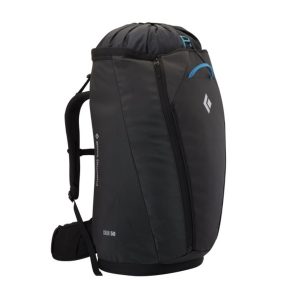
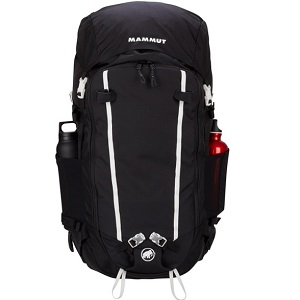
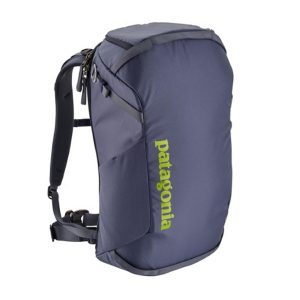
50 L
50 L
45 L
If you liked this article, we think you’ll also enjoy:
- Rock Climbing Gear Guide: Best Climbing Packs
- New 2017 Petzl GriGri + (Plus) Review and Comparison
- Review of the New 2017 Mad Rock Duo Pad
- Gear Review: Wild Country’s New Friend Cams (Updated and Re-Engineered)
Lastly, don’t forget to check out our most popular articles ever published, free rock climbing eBooks, and the internet’s best climbing gear sales.

